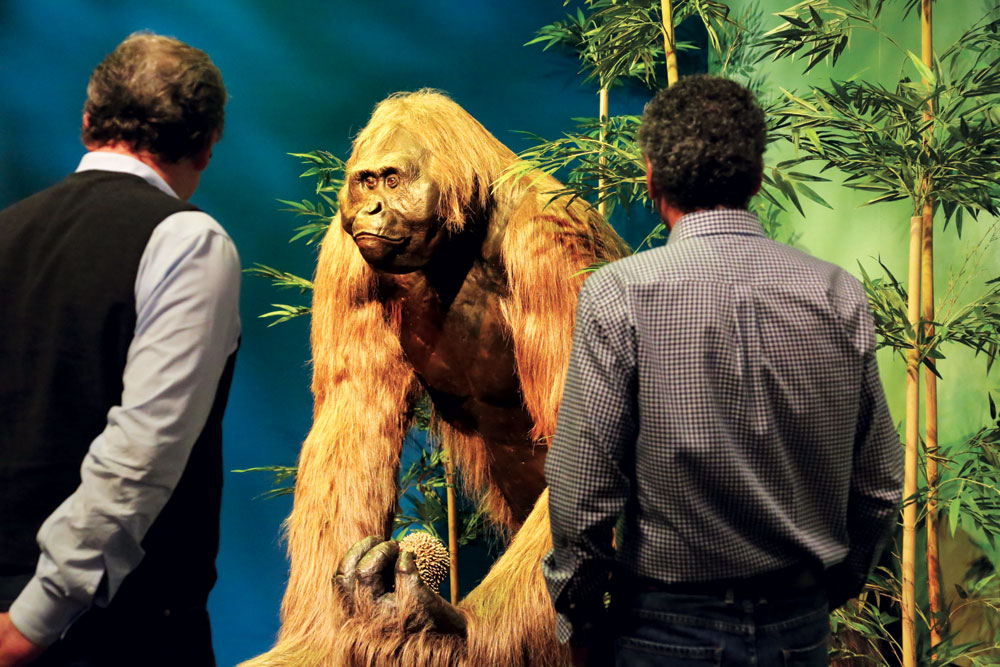
The fearsome kraken was the largest sea monster ever imagined, with tentacles as long as a ship’s mast. In the 1850s, scientists recognized the kraken as a real, much smaller animal: the giant squid.
They are the stuff of dreams—and nightmares: creatures conjured from our imaginations as friends or foes continue to inhabit stories told in books and movies. Through the centuries, dragons, unicorns and mermaids tell the tales of human struggle and triumph.
The Denver Museum of Nature & Science brings imagination to life with its Mythic Creatures: Dragons, Unicorns, and Mermaids exhibit, on display until September 7.
From ancient sea tales to Pirates of the Caribbean movies, why do we continue to be fascinated with made-up creatures? “Even in 2015, these creatures are interesting because we love to let our imagination run wild,” said Samantha Richards, an educator for the exhibit. “We know so much about the world now, but as humans we always want to know what else is out there—that is what drives scientists to the bottom of the ocean or outer space.”
Throughout history, humans have caught glimpses of mythic creatures sliding beneath the waves, running silently through the trees, and soaring above the clouds. The exhibit sections, Water, Land, Air and Dragons, explore how these fantastical beings came to be and how the tales surrounding them have evolved.
Origins of mythic creatures can often be traced to fossil records, Richards said. “The griffin in Greek mythology—part eagle, part lion—was probably an interpretation of fossils from the Protoceratops dinosaur. Fantastic creatures were thought to be real and even appeared in scientific textbooks. There wasn’t enough scientific understanding to know that just because a creature hadn’t been seen, didn’t mean it wasn’t real. This exhibit explores how the scientific process has changed—how we’ve learned more about the natural world.”
“Evidence” of dragons was found in Austria in the 1200s. “Fossilized skulls of the woolly rhinoceros, an Ice Age animal, were purported as proof,” Richards said. “Dragon bones and blood—actually rocks and tree resin—were sold in Medieval Europe as remedies for various ills.”
Stories of dragons’ fire-breathing capacities might have originated in the properties of caves and swamps, Richards said. “In caves and swamps in Europe, methane gas built up and using torches caused an explosion. Fire-breathing dragons were an explanation, since people didn’t understand about the methane.”

The fearsome kraken was the largest sea monster ever imagined, with tentacles as long as a ship’s mast. In the 1850s, scientists recognized the kraken as a real, much smaller animal: the giant squid.
Found body parts from real animals became the basis for some of our favorite fantastic creatures. “The unicorn was thought to have magical powers, including purifying water,” Richards said. “The tusks of narwhals, Arctic whales, were presented as evidence of the existence of unicorns.”
Other legendary critters were conjured from misinterpretations of real animals. Sea monsters were a concern for sailors in the 1500s, and frightening rumors ran rampant. The giant kraken was described as having tentacle-arms that sank ships. In the 1850s, scientists recognized the kraken as an authentic animal: the giant squid.Some imaginings were the result of wishful thinking. “Sailors at sea too long were lonely for female companionship and might have mistaken manatees for mermaids,” Richards said.
A few creatures in the exhibit are real but extinct animals. Gigantopithecus, an enormous ape that became extinct 300,000 years ago, is the basis for stories all over the world, including King Kong and Bigfoot. A very rare Aepyornis egg is evidence of a 9-foot flightless bird that became extinct in the 1500s and inspired tales of an enormous bird of prey.

Above left: Wishful imaginings: after many months at sea, sailors missing female companionship might have fancied manatees to be mermaids. Mermaids were thought to be beautiful but dangerous, so some ships avoided mermaid figureheads for fear they would bring bad luck.
Above right: Live faeries, fauns, a mermaid and other magical folk were on hand for the exhibit opening, courtesy of Festival of Faerie, which will hold their annual day-long event June 20 in Lafayette featuring a parade, music, dancing, storytelling and an assortment of imaginary characters including dragons, leprechauns and the Fairy Queen. See www.festivaloffaerie.com.
Colorado’s own legendary creatures are also on display, including the jackalope and the fur-bearing trout. “The jackalope, a jack rabbit with antelope horns, was made by a taxidermist in the 1930s,” said Richards. “The idea may have started with sightings of rabbits with a pappiloma virus that causes horn-like warts on the head. The fur-bearing trout was a hoax that promoted the existence of furry trout in the Arkansas River. It’s all good fun.”
Children will love the activity area, where they can make their own mythical creatures using overlapping stencils of real creatures.
“Over the centuries, mythical creatures helped explain things in the natural world that we couldn’t explain,” said Richards. “They are in the stories about good and evil; it’s a way to explore the dualities. They fight to keep the world in balance.”

Strange but real: Gigantopithecus, an enormous ape that became extinct 300,000 years ago, is the basis for stories all over the world, including King Kong and Bigfoot.




0 Comments